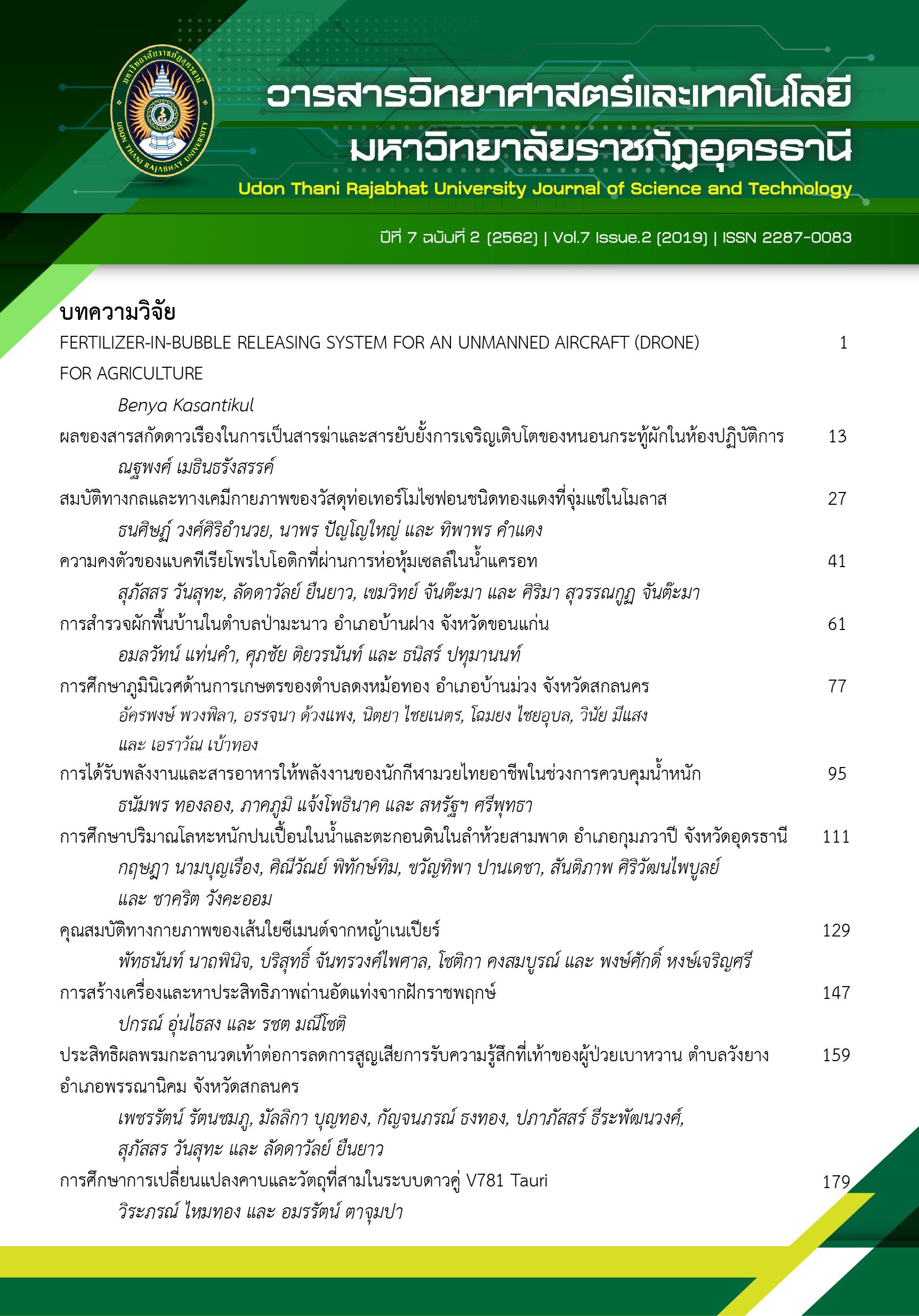EFFECT OF MAROGOLD EXTRACT AS THE INSECTICIDAL AND GROWTH INHIBITION ON COMMON CUTWORM, SPODOPTERA LITURA (FABRICIUS) (LEPIDOPTERA: NOCTUIDAE) IN LABORATORY
Main Article Content
Abstract
One of the problems in kale cultivation is infestation where kale is destroyed by pests, especially, the common cutworm, Spodoptera litura (Fabricius), which is one of the major pests in kale production in Thailand. The objective of this research is to study the effect of marigold extract as the insecticidal and growth inhibition on the third instar of common cutworm.
The various concentrations of marigold extract: 0, 0.25, 0.5, 1, 2, 4 and 8% (w/v) were applied. The treatments were arranged in a completely randomized design (CRD) and replicated 5 times on 10 adults. The experiment was conducted at biology laboratory. The results found that the insecticide and growth inhibition of marigold extract on the third instar of common cutworm were significantly effective (p<0.05) when compared with the controlled. When the marigold extract was higher, the mortality of cowpea aphid was higher. At the concentration of 8% (w/v), the percent of mortality on the third instar of common cutworm was the highest value of 100% and LC 50 values with 0.95 and 0.38% (w/v) were at 24 and 48h, respectively. In the growth inhibition at the concentration of 0.25% (w/v), the percent mortality of pupae was 32.0% and the times of development of pupae and adult stages were 7.40 + 0.48 and 8.20 + 0.48 days, respectively. Whereas the percent mortality of pupae was 0.00% and the times of development of pupae and adult stages were 4.60 + 0.48 and 5.40 + 0.48 days in control, respectively.
Article Details
References
พัชรินทร์ คูณเศรษฐ. (2560). สินค้าผัก แช่เย็น แช่แข็งและแห้ง. สำนักส่งเสริมการค้าสินค้าเกษตรและอุตสาหกรรม กรมส่งเสริมการค้าระหว่างประเทศ.
รัตนาภรณ์ พรหมศรัทธา, มัณฑนา มิลน์ และ อารมณ์ แสงวนิชย์. 2544. การศึกษาองค์ประกอบทางเคมีของดาวเรือง, น. 406-409. ในรายงานการประชุมทางวิชาการของมหาวิทยาลัย เกษตรศาสตร์ ครั้งที่ 39, 5-7 กุมภาพันธ์ 2544. กรุงเทพฯ.
สมศักดิ์ สิริพลตั้งมั่น, อุราพร หนูนารถ, สมรวย รวมชัยอภิกุล และ ศรีจำนรรจ์ ศรีวันทรา. (2544). แมลงศัตรูผัก เห็ด และไม้ดอก. กรุงเทพฯ: โรงพิมพ์ชุมนุมสหกรณ์การเกษตรแห่งประเทศไทย.
Abbas, N., Ullah, S., Shad, S. A., Razaq, M. Waheed, A., & Aslam, M. (2014). Resistance of Spodoptera litura (Lepidoptera: Noctuidae) to profenofos: Relative fitness and cross resistance. Crop Protection, 58, 49-54.
Abbott, W. S. (1925). A method for computing the effectiveness of an insecticide. Journal of Economic Entomology, 18, 265–267.
Aktar, M. W., Sengupta, D., & Chowdhury, A. (2009). Impact of pesticides use in agriculture: their benefits and hazards. Interdisciplinary Toxicology, 2(1), 1–12.
Chauhan, D., & Mishra, V. K. (2016). Effect of medicinal plant extracts on growth and development of tobacco caterpillar, Spodoptera litura (Fabricius). International Journal of Agriculture, Environment and Biotechnology, 9(3), 435-442.
Dubey, N. K., Shukla, R., Kumar, A., Singh, P., & Prakash, B. (2010). Prospects of botanical pesticides in sustainable agriculture. Current science, 98(4), 479-480.
Ffrench-Constant, R. H. (2013). The molecular genetics of insecticide resistance. Genetics, 194, 807–815.
Finney, D. J. (1971). Probit Analysis. 3rd ed. London: Cambridge University Press.
Isenring, R. (2010). Pesticides reduce biodiversity. Pesticides News, 88, 1-4.
Isman, M. B. (2006). Botanical insecticides, deterrents, and repellents in modern agriculture and an increasingly regulated world. Annual Review of Entomology, 26(2), 81-94.
Javier, A. M. V., Ocampo, V. R., Ceballo, F. A., & Javier, P. A. (2017). Insecticidal activity of selected essential oil extracts against common cutworm, Spodoptera litura Fabricius (Lepidoptera: Noctuidae). Philippine Journal of Science, 146(3), 247-256.
Mikami, A. Y., & Ventura, M. U. (2008). Repellent, antifeedant and insecticidal effects of neem oil on Microtheca punctigera. Brazilian Archives of Biology and Technology, 51(6), 1121-1126.
Mitra, A., Chatterjee, C., & Mandal, F. B. (2011). Synthetic chemical pesticides and their effects on birds. Research Journal of Environmental Toxicology, 5(2), 81-96.
Nicolopoulou-Stamati, P., Maipas, S., Kotampasi, C., Stamatis, P., & Hens, L. (2016). Chemical pesticides and human health: the urgent need for a new concept in agriculture. Frontiers in Public Health, 4, 1-8.
Oliveira, C. M., Auad, A. M., Mendes, S. M., & Frizzas, M. R. (2014). Crop losses and the economic impact of insect pests on Brazilian agriculture. Crop Protection, 56, 50-54.
Peris, N. W. and Kiptoo, J. J. (2017). Potential of botanical extracts in the control of kale aphids (Brevicoryne brassicaea) and their effect on the parasitic wasp (Aphidius ervi). Asian Research Journal of Agriculture, 4(3), 1-6.
Prakash, A., Rao, J., & Nandagopal, V. (2008). Future of botanical pesticides in rice, wheat, pulses and vegetables pest management. Journal of Biopesticides, 1(2), 154–169.
Pino, O., Sánchez, Y., & Rojas, M. M. (2013). Plant secondary metabolites as an alternative in pest management. I: Background, research approaches and trends. La Revista de Protección Vegetal, 28(2), 81-94.
Samia, P. R., De Oliveira, R. L., Moscardini. V. F., & Carvalho, G. A. (2016). Effects of aqueous extracts of Copaifera langsdorffii (Fabaceae) on the growth and reproduction of Spodoptera frugiperda (J. E. Smith) (Lepidoptera: Noctuidae). Neotropical Entomology, 45, 580–587.
Sarwar, M., & Salman, M. (2015). Insecticides resistance in insect pests or vectors and development of novel strategies to combat its evolution. International Journal of Bioinformatics and Biomedical Engineering, 1(3), 344-351.
Sintim, H. O., Tashiro, T., & Motoyama, N. (2009). Response of the cutworm Spodoptera litura to sesame leaves or crude extracts in diet. Journal of Insect Science, 9, 1-13.
Summarwar, S. (2016). Toxicity of neem against different larval instars of Spodoptera litura. International Journal of Food, Agriculture and Veterinary Sciences, 6(1), 66-71.


